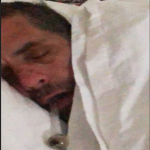viewtopic.php?t=32896&highlight=
I came across some unexpected results. (For background please read that post first.)
This was done using the Respironics M-series machines. I expect this to apply similarly for most of Respironics machines, possibly to other brands too.
For a given mask, as I gradually increased the pressure, say in steps of 1cm, the measured intended leak did not change at all, for many steps. But it was definitely different for two different masks I had tried, and for both masks at some pressure the leak values were in the right ballpark as in their specification.
So I looked into the detailed numbers used in plotting the leak graphs in the daily detailed reports of Epro, I came to a rather unexpected finding. The leak values (LPM) reported are very coarse, they do not increase gradually, but they jump in big steps of 7 LPM!!
When we normally talk about leaks for Respironics of say, 25 LPM, this includes the intended leak, say 20 LPM, for that mask at that pressure. So the actual unwanted leak values we are interested in are generally small, in the range of 5 to 15 (in the above example 25-20=5). So if the reporting of this jumps in steps of such a large value as 7 LPM, then all our observations of leaks and conclusions could easily be misleading us.
Let us look at a specific Epro daily leak graph.

The above is from Epro directly, for day where the leak was not changing much during the night. The squiggles are small and the graph is compressed, it is hard to really determine the actual point values. So I have gathered the data from the database for the same day and replotted manually, and it is like below:

Please note that for the above the vertical y axis is at midnight, and the horizonal x axis is at 4 LPM.
The important point to note is that the horizontal grid lines are at steps of 7 LPM, and all the points of the graphs fall exactly on those lines. This is not a coincidence, and in fact for all leak graphs I analyzed, all points were just like that. There was no leak value in any graph which was not in steps of 7LPM, starting with 4LPM.
Another point to note: Since these are at discreet places, if the actual leak were to remain close to a constant value of say 28.5, the graphs could randomly and constantly going back and forth between 25 and 32 all thru the night! So, if the pressure was at a point where the intended leak would be at a midpoint like the above, then even without any unintended leaks or variations in leaks, the graph could look quite squiggly; but if the pressure was at another setting where the unintended leak was close to say 25 or 32, then with no real leak the graph might be very quiet! So this would result in two very different looking leak graphs with almost the same type of leaks and leak changes at night!!
Let us look at another day's data.


Note that the overall leak is a bit lower, actually only one notch lower, and the values jumped around 11,18, and 25 (again in steps of 7).
Some potential implications
This coarse display of leak data has many potential implications for us who are trying to tune our system or trying to find out how well we are controlling leaks. Let me briefly list a couple.
Many of us here, especially in the early stage of getting used to cpap, are quite focused on the leak and leak control, rightfully so. Controlling leaks is important for effective therapy. We experiment with different methods, such as using sealing gels, taping, stabilizing straps for masks, taking a hacksaw to the headgear, or try out different type of masks. When we see a very quiet graph one day, we assume that what we did the night before was very good, or vice versa. From the above it should be clear, that such large looking variations may simply be by accident as a result minor changes in leaks.
There are always very small leaks in all the rotating type of hose couplings, and angle joints. Though small, once you have controlled your big leaks, they become significant. Whether there is very little leak or significant leak at one of those joints one night may depend on the relative positions of the rotating joint, or the slight changes in pull of the hose at the joint. Such simple normal variations may cause a totally different looking graph.
Sometimes we experiment with pressure changes. A pressure change of 1 cm may look like the leak was almost gone, or got real worse. Again in might simply be shifting the intended leak value to a midway point or closer to one of the leak step values.
Finally, an explanation for the unexpected results of leak measurement method I referred to at the beginning of this post: We have to change the pressure in steps of 1cm or so a few times before we will see a change in leak. Simply by looking at the specification of the leak for our mask, and from our pressure setting, we cannot expect what the intended leak would be as shown by the Epro software, it could be +7 or -7 of that value from the spec!!










